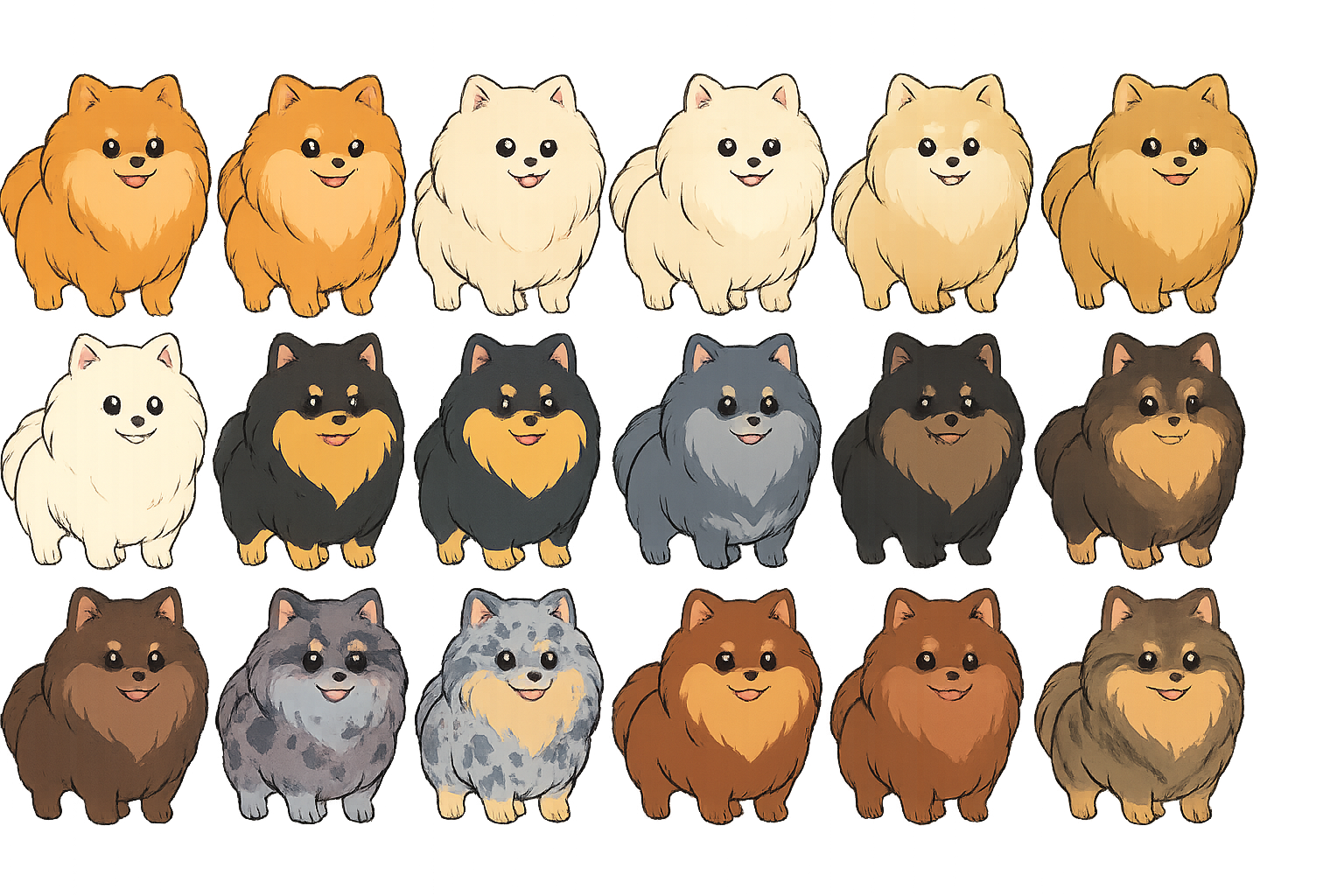ABOUT — COLOR GENETICS
Table of Contents
Introduction
Agouti (A-Locus)
CBD103 (K-Locus)
MC1R (E-Locus)
TYRP1 (B-Locus)
MLPH (D-Locus)
PMEL17 (M-Locus)
MITF (S-Locus)
Progressive Graying (G-Locus)
Intensity Modifiers (I-Locus)
Dermatopathies
Color Genetics IN POMERANIANS
Pomeranians carry every major canine coat-color locus, yet decades of selection for plush guard hairs and a “foxy” expression have altered how those alleles present. The matrix below lists each locus in its accepted dominance order, followed by breed-specific expression notes and the health data relevant to that allele combination.
Agouti (A-locus, ASIP)
| Allele | Dominance | Pigment Pattern | Notes on Shade |
|---|---|---|---|
ay |
Dominant over all | Red/orange sable; black limited to hair tips. | Cream modifiers (I-series) can strip reddish hue, leaving clear “white” sables. |
aw |
Recessive to ay, dominant to at, a |
Wolf-sable (banded hairs) that can silver with age. | Often greys out by 2 yrs if also G/- (progressive graying). |
at |
Recessive to ay, aw |
Black-&-tan or blue-&-tan pattern; points can be so dense that only “spectacles” remain. | Tan reduced if EM/- (mask) overlays muzzle. |
a |
Most recessive | Solid black when other loci allow eumelanin; rare in the variety. | Very uncommon; most “black” Pomeranians are KB dominant black. |
CBD103 (K‐locus)
KB > kbr > ky. A single KB allele overrides the Agouti pattern, creating a solid eumelanin coat—black, blue, liver, or lilac depending on B- and D-loci. Brindling (kbr) is rarely maintained by show breeders because it breaks the outline.
MC1R (E-locus)
EM (mask) → black muzzle/ear fringe on sable pups until guard hairs lengthen.
E normal switching.
e recessive red/cream eliminates all eumelanin from hair shafts; only skin points stay pigmented.
An e/e dog cannot show merle, brindle, or black-&-tan pattern because no eumelanin reaches the hair—critical when ordering coat-color DNA panels for cream sires.
TYRP1 (B-locus)
Five loss-of-function alleles (bs, bd, bc, plus “cocoa” and “mocha” variants). Homozygous recessive (bb) yields chocolate/liver pigment; in sables the guard-hair tipping softens to cinnamon. Recent work shows cocoa derives from a promoter deletion distinct from classic TYRP1 variants.
MLPH (D-locus)
D (full) > d (dilute). dd converts black→blue and liver→lilac. A 2020 Genes paper identified a third functional MLPH mutation producing dilution in Spitz breeds. Roughly 40 % of dilute Pomeranians developed microscopic melanosome clumping, predisposing to Color Dilution Alopecia (CDA)—a late-onset follicular dystrophy with recurrent pyoderma.
PMEL17 (M-locus)
Merle (M) versus non-merle (m). Merle mottles only eumelanin; pheomelanin fields remain solid. The “cryptic” mc allele carries a truncated SINE insertion and may appear non-merle on phenotype yet produce merle pups. Double-merle (M/M) is strongly associated with deafness, microphthalmia, and coloboma; AKC and major breed clubs disallow merle × merle matings.
MITF (S-locus)
S (solid) and sp (piebald). Parti-color Poms are homozygous sp; heterozygotes tend toward Irish spotting. Excessive white (>80%) can amplify merle-linked deafness when present together.
Progressive Graying (G-locus)
Dominant G fades eumelanin after birth. In wolf-sables G masks the dark banding by 18 months, creating the prized pale silver outer coat. Breeders pairing G/g wolf-sable males to G/g females risk “washed-out” puppies if intensity (I-series) is also low.
Intensity Modifiers (I-series)
Not yet mapped, but GWAS data in 2022 points to regulatory regions near the KITLG gene in Spitz breeds. Two high-intensity alleles (Ideep) increase pheomelanin production, yielding saturated mandarins; low-intensity (i) lightens to champagne.
Epistatic Interplay & Color-Linked Dermatopathies
| Locus Combo | Risk Condition | Mechanism & Evidence |
|---|---|---|
dd (MLPH) ± bb |
Color Dilution Alopecia (CDA) | Clumped “macromelanosomes” rupture hair shafts; c.-22G>A SNV confirmed by PCR-RFLP in affected coats. |
M/M or M + piebald |
Deafness & ocular defects | PMEL17 double insertion disrupts neural crest pigment cells; breeder surveys show 25–55% bilateral deafness. |
| Woolly coat + male sex | Alopecia X (Black Skin Disease) | Cox model across 211 Poms revealed 2.4× hazard ratio; hair-cycle genes (Wnt, Shh, p63) down-regulated in lesional skin. Darker eumelanin coats (black, blue) over-represented in clinical cohorts, suggesting oxidative stress may hasten telogen arrest. |
ay/ay + e/e |
Coat break delay | Recessive red suppresses eumelanin; low oxidative signaling slows anagen initiation—observed as “cottony” transitional coat at 6 months. |
For breeders and owners seeking a deeper understanding of their Pomeranian's genetic profile, EmbarkVet.com offers comprehensive DNA testing that screens for coat color alleles, genetic health conditions, and carrier status. These results can clarify hidden traits, confirm genotype pairings, and help avoid combinations linked to conditions like color dilution alopecia or double-merle complications.
-
Evaluation of phenotypic risk indicators for Alopecia X in Pomeranian dogs. J. Vet. Dermatol., 2024. pubmed.ncbi.nlm.nih.go
p63 immunoexpression in hair follicles of normal and Alopecia X Pomeranians. Vet. Pathol., 2023. pubmed.ncbi.nlm.nih.gov
Van Buren S.L. et al. A third MLPH variant causing coat color dilution in dogs. Genes 11, 639 (2020). pro.dermavet.com
PCR-RFLP confirmation of color dilution alopecia in dogs. Cytologia, 2021. pmc.ncbi.nlm.nih.gov
Schmutz S.M. & Berryere T.G. TYRP1 mutations and brown coat color. Mamm. Genome 18, 690-6 (2007). researchgate.net
Donner J. et al. Novel “cocoa” TYRP1 allele in French Bulldogs. Genes 11, 855 (2020). pmc.ncbi.nlm.nih.gov
AKC Canine Health: Merle pattern and associated sensory defects (2022). akc.org
Zooplus Magazine. “Merle: beauty with a dark side” (2024). zooplus.co.uk
OMIA entry: MLPH-related coat dilution, ID 000031-9615 (updated 2025). omia.org
